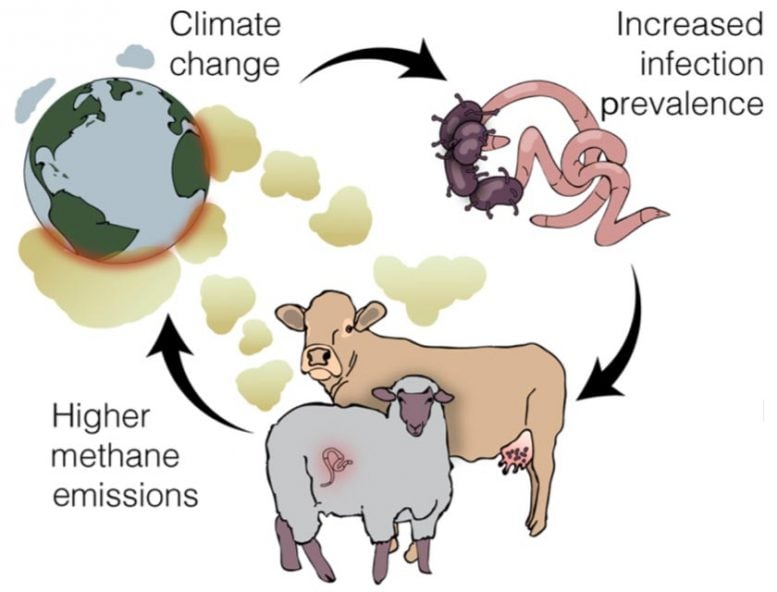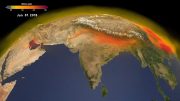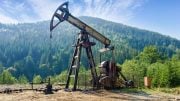
Researchers identified a potential feedback loop arising from interactions among climate, infectious diseases, and methane emissions. Credit: Image courtesy of Trends in Ecology & Evolution
Sicker livestock may increase climate woes: More parasites means higher emissions of potent greenhouse gas.
Climate change is affecting the spread and severity of infectious diseases around the world — and infectious diseases may in turn be contributing to climate change, according to a new paper in Trends in Ecology & Evolution.
The research, led by Vanessa Ezenwa, a professor of ecology at the University of Georgia, and funded by the Living Earth Collaborative at Washington University in St. Louis, describes how parasites can cause animals to produce more methane, a powerful greenhouse gas.
“There is evidence that climate change, and warming temperatures in particular, are impacting some infectious diseases and increasing their prevalence,” Ezenwa said. “If that’s happening for livestock diseases, and simultaneously higher prevalence is triggering increased methane release, you could end up with what we call a vicious cycle.”
Methane is a greenhouse gas with an effect on global warming 28-36 times more potent than carbon dioxide. In the past 10 years, atmospheric methane concentrations have increased rapidly, with about half of the increase attributed to emissions from livestock.
Here, the researchers — a team of ecologists, veterinarians, and One Health experts — formed a working group led by Amanda Koltz, senior scientist in biology in Arts & Sciences at Washington University, to study the effects of parasites on ecosystems — including their impacts on climate.
“Infectious diseases impact all animals, but our understanding of how their effects extend to the broader ecosystem is still limited,” Koltz said. “For example, parasite-host interactions can shape host physiology, behavior, and population dynamics — some of those impacts are likely to have widespread, cascading effects on ecosystem-level processes.”
The review focused on ruminant livestock, a group that includes cows, sheep, and goats. These animals are known to be major contributors to global methane emissions and host to many parasites and pathogens as well. They are also an important part of the global food supply.
The researchers examined data from studies of sheep that showed that animals infected with intestinal worms produced up to 33% more methane per kilogram of feed than uninfected animals. The methane is released through normal body functions of ruminants. Infection also causes sheep to grow more slowly, increasing the time to slaughter and thereby increasing total methane emitted by the infected animals.
They also reviewed studies of dairy cattle suffering from mastitis, a common disease caused by bacterial infections. These studies revealed that cows with mastitis release up to 8% more methane per kilogram of milk produced than uninfected cows.
The authors calculated that infectious diseases in ruminant livestock could lead to a sizable increase in methane released into the atmosphere.
For example, the Food and Agriculture Organization of the United Nations projects that global livestock production will increase by 2.7% annually, and that methane emissions will increase by more than 20%, from 2017 to 2050. But when the effects of parasitic worm infections are incorporated into these calculations, the study’s authors estimate that methane emissions from livestock could increase instead by as much as 82% over the same period.
“With human consumption of meat increasing four- to five-fold since the 1960s along with the ever-increasing impacts from climate change, this vicious climate-disease cycle is one more example of the interconnection of our greatest planetary ills — climate change and emerging infectious diseases,” said Sharon Deem, the director of the Saint Louis Zoo Institute for Conservation Medicine and a co-author of the paper.
The team’s findings highlight the need to take infectious diseases into account when modeling future climate scenarios to ensure that they don’t underestimate methane emissions.
“The vicious cycle between climate impacts on disease and disease impacts on climate is striking,” said co-author Aimée Classen, a professor of ecology and evolutionary biology and director of the University of Michigan Biological Station. “Our study highlights that scientists need to incorporate both animals and disease into the experiments and models used to predict future carbon emissions.”
Reference: “Infectious Diseases, Livestock, and Climate: A Vicious Cycle?” by Vanessa O. Ezenwa, David J. Civitello, Brandon T. Barton, Daniel J. Becker, Maris Brenn-White, Aimée T. Classen, Sharon L. Deem, Zoë E. Johnson, Susan Kutz, Matthew Malishev, Rachel M. Penczykowski, Daniel L. Preston, J. Trevor Vannatta and Amanda M. Koltz, 7 October 2020, Trends in Ecology & Evolution.
DOI: 10.1016/j.tree.2020.08.012
In addition to Ezenwa, Koltz, Deem and Classen, the study’s co-authors are David J. Civitello and Matthew Malishev of Emory University; Brandon T. Barton and Zoë E. Johnson of Mississippi State University; Daniel J. Becker of Indiana University; Maris Brenn-White of the Saint Louis Zoo; Susan Kutz of the University of Calgary; Rachel M. Penczykowski of Washington University; Daniel L. Preston of the University of Wisconsin-Madison; and J. Trevor Vannatta of Purdue University.









Funny how one never sees claims for positive outcomes for warming, despite the most biodiverse region on Earth being the tropics. No responsible farmer/rancher would knowingly allow their animals to be sick. There are readily available treatments for both intestinal worms and bacterial infections.
Most processes on Earth are negative feedback loops, preventing runaway conditions. If that were not the case, Earth would have reached anyone of several ‘tipping points’ millions of years ago. That obviously hasn’t happened!
Note that the article uses percentage increases, and never mentions how much the temperature might be increased by the speculated increase in ruminant methane. Going from 1 molecule of something per unit-volume, to 2 molecules, is an increase of 100%. Yet, the concentration may be so low as to be impossible to measure. Even at higher concentrations the impact may be insignificant.
Nor does the article mention that methane has a much shorter life span in the air, rather quickly oxidizing into water and carbon dioxide. Water is by and far the most important ‘greenhouse gas,’ followed by CO2, whose absorption bands largely overlap the thermal absorption bands of water. There is a lot of speculative hand waving and appealing to supposed authority when the science is far from “settled.”
The quality of astrolclimatology is abysmal, with grant seekers jumping on the Band Wagon to get funding, and they provide speculation about potential problems without benefit of any estimate of probability, relying on words such as “could, may, might, and possibly,” to convey a sense of urgency to what is unproven.
The day that prominent alarmists are willing to publicly defend their claims, in open debate with scientists who question their claims, will be the day we will learn the truth.
I find it extremely sad that these people are blaming the cattle for what is a mismanagement of resources.
The animals existed long before humans domesticated them, feedlots have only existed for the last 130 years, the conventional industrial cattle raising method is not even that old, and is to blame.
When these same animals are raised in pasture, rotated often instead of just leaving them loose, they have shockingly less parasites and diseases, and contribute to soil health. When you allow animals to graze the ground bare, they ingest more parasites because parasites live closer to the ground. Also, animals need to be rotated so they don’t eat forage that has been contaminated with their own excretions. Rotating the animals daily, also almost completely eliminates problems with their hooves and minimizes parasites.
This study is flawed right from the start, as it begins with the wrong proposition. Assumes cattle is bad right from the start and assumes that there is only one method to raise the animals when there are definitely alternatives that are regenerative for the soil, capture carbon in much higher amounts than planting rickety trees, that recycle nutrients and break down less desirable compounds.
The study seeks to project future outcomes but doesn’t even do justice to the present. How is this going to solve anything?
Climate change has,is,and will only be slightly affected by life on earth. Natural disaster is the cause. The suns gravitational pull is literly pulling back everything including earth back into it to reunite and reform after the big bang. Theres the sun,the two planets and asteroid belt before earth. And after earth is the outter most atmosphere of the sun that is a vapor atmosphere that we passed through to form our last ice age.Earth has gone from pangea ice age to a defrost stretch marked planet divided by global warming causing techtonic shifts. Thats why all planet before mars wether wet(earth),burning(venus),or dry and melting(mercury),all of them went through the same planetary development process. So earth will evaporate in time as it gets closer to the sun to replace venus as vebus replaces mercury and mercury melts and merges into the sun.By them mars will develope its ice age and be ready for mankind to survive through A.I. and reinhabit mars to restart there just as we restarted on earth from venus last…indians didnt draw aliens or gods…they drew humans repeating history…history alwaysnrepeats itself. We will go back to the stone age…but through space we will evolve per planet and continue to govern as God.Giverment Of Destruction…American Giv founded upon the Bible(Basic Instructions Before Leaving Earth) and for non believers theres always Politics (People Over Loading International Thoughts Into Circumstances Secretly.as much as the sheep(public) dont like the sheepdog(gov)without them we would perish per planet.musk recently said the best nutshell version…”Evolve or Perish”
The “micro-focus” view in this piece misses a lot.
Ruminants convert a lot of ag waste into protein that would otherwise decay and release greenhouse gas anyway. “Cellulosic ethanol” was supposed to short-circuit this but so far it’s been a flop; a federal law was even passed to mandate the production of millions of gallons, you can web search for the results (a few tens of thousands of gallons at hideous subsidized expense).
I just read reports from Brazil lamenting the insatiable appetite for beef exported to China. More rain forest to produce meat for export. Did the globalists who promoted “free trade” with China think this through? I don’t recall anyone crying about the environment at the time WTO for China passed. US policymakers seem to be navel-gazing narcissists who pretend domestic mandates are the center of the universe.
Speaking of which, the “science” is that Chinese emissions–the biggest and fastest-growing–are disrupting North American weather patterns. This was published 6 years ago by Texas A&M–China even helped pay for the research–but it never made any of the corporate network “news”.
And still US policy subsidizes some of the most wasteful behavior imaginable, like allowing EBT funds to be spent on mountains of plastic-wrapped junk food. Go to any US school site and you will see; the products contribute to the rising and it appears accelerating obesity and diabetes crisis to ever-younger levels. This factor is perhaps the most critical risk for negative Covid outcomes. Vast amounts of fossil-fuel-generated fertilizer is expended to grow corn to make “snack chips” with virtually no nutritive value, they are one of the worst forms of “empty calories” outside the sweetened beverages various experts rail against. (The fructose corn syrup used for them is made from corn too). The Gates foundation just got Rwanda to abandon most of it’s domestic agriculture to grow corn for export.